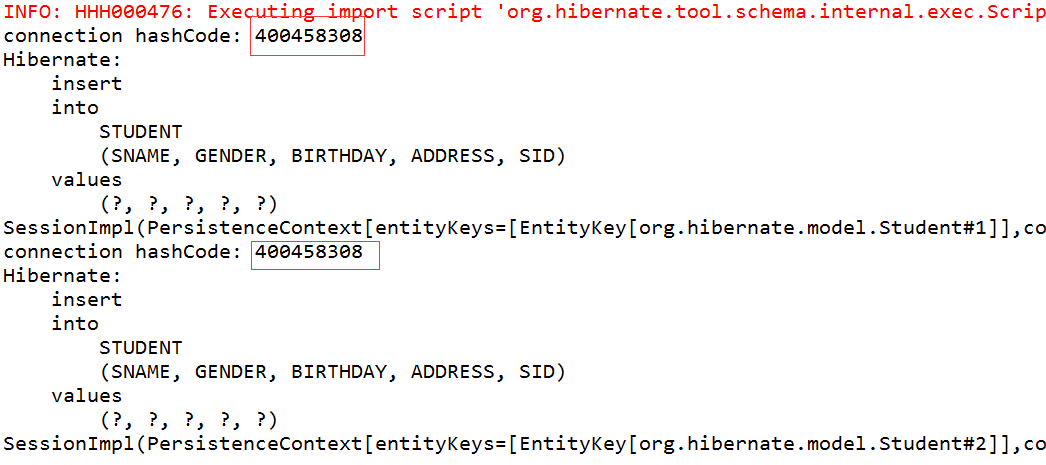© 版权声明:本文为博主原创文章,转载请注明出处
如何获取session对象
1. openSession
2. getCurrentSession
- 如果使用getCurrentSession需要在hibernate.cfg.xml中进行如下配置:
如果是本地事务(jdbc事务)
<property name="current_session_context_class">thread</property>
如果是全局事务(jta事务)
<property name="current_session_context_class">jta</property>
- 全局事务和本地事务
本地事务适合对一个数据库进行操作,全局事务适合对多个数据库进行操作;
当存在多个数据库是,也就存在多个session,这样本地事务就无法对多个session进行统一管理,因此可以使用全局事务。
3. openSession和getCurrentSession区别
- getCurrentSession在事务提交或者回滚之后会自动关闭session,而openSession需要你手动关闭session。如果使用openSession而没有手动关闭,多次之后会导致连接池溢出
- openSession每次创建新的session对象,getCurrentSession使用现有的session对象
实例
1.项目结构

2.pom.xml
<project xmlns="http://maven.apache.org/POM/4.0.0" xmlns:xsi="http://www.w3.org/2001/XMLSchema-instance"
xsi:schemaLocation="http://maven.apache.org/POM/4.0.0 http://maven.apache.org/maven-v4_0_0.xsd">
<modelVersion>4.0.0</modelVersion>
<groupId>org.hibernate</groupId>
<artifactId>Hibernate-Session</artifactId>
<packaging>war</packaging>
<version>0.0.1-SNAPSHOT</version>
<name>Hibernate-Session Maven Webapp</name>
<url>http://maven.apache.org</url>
<properties>
<project.build.sourceEncoding>UTF-8</project.build.sourceEncoding>
<hiberante.version>5.1.6.Final</hiberante.version>
</properties>
<dependencies>
<!-- junit -->
<dependency>
<groupId>junit</groupId>
<artifactId>junit</artifactId>
<version>4.12</version>
<scope>test</scope>
</dependency>
<!-- hibernate -->
<dependency>
<groupId>org.hibernate</groupId>
<artifactId>hibernate-core</artifactId>
<version>${hiberante.version}</version>
</dependency>
<!-- mysql -->
<dependency>
<groupId>mysql</groupId>
<artifactId>mysql-connector-java</artifactId>
<version>5.1.42</version>
</dependency>
</dependencies>
<build>
<finalName>Hibernate-Session</finalName>
</build>
</project>
3.hibernate.cfg.xml
<?xml version="1.0" encoding="UTF-8"?> <!DOCTYPE hibernate-configuration PUBLIC "-//Hibernate/Hibernate Configuration DTD 3.0//EN" "http://www.hibernate.org/dtd/hibernate-configuration-3.0.dtd"> <hibernate-configuration> <!-- 配置SessionFactory --> <session-factory> <!-- 设置数据库连接属性 --> <property name="connection.username">root</property> <property name="connection.password">***</property> <property name="connection.driver_class">com.mysql.jdbc.Driver</property> <property name="connection.url"> jdbc:mysql:///hibernate?useSSL=true&characterEncoding=UTF-8 </property> <!-- 设置常用属性 --> <property name="show_sql">true</property><!-- 输出SQL --> <property name="format_sql">true</property><!-- 格式化SQL --> <property name="dialect">org.hibernate.dialect.MySQL5InnoDBDialect</property><!-- 方言 --> <property name="hbm2ddl.auto">create</property><!-- 检查数据库表结构是否一致,不一致更新,一致忽略 --> <property name="current_session_context_class">thread</property><!-- 本地事务(jdbc事务) --> <!-- 引入映射文件 --> <mapping resource="hbm/Student.hbm.xml"/> </session-factory> </hibernate-configuration>
4.Student.java
package org.hibernate.model;
import java.util.Date;
public class Student {
private long sid; // 学号
private String sname; // 姓名
private String gender; // 性别
private Date birthday; // 出生日期
private String address;// 地址
public Student(long sid, String sname, String gender, Date birthday, String address) {
super();
this.sid = sid;
this.sname = sname;
this.gender = gender;
this.birthday = birthday;
this.address = address;
}
public long getSid() {
return sid;
}
public void setSid(long sid) {
this.sid = sid;
}
public String getSname() {
return sname;
}
public void setSname(String sname) {
this.sname = sname;
}
public String getGender() {
return gender;
}
public void setGender(String gender) {
this.gender = gender;
}
public Date getBirthday() {
return birthday;
}
public void setBirthday(Date birthday) {
this.birthday = birthday;
}
public String getAddress() {
return address;
}
public void setAddress(String address) {
this.address = address;
}
}
5.Student.hbm.xml
<?xml version="1.0" encoding="UTF-8"?>
<!DOCTYPE hibernate-mapping PUBLIC
"-//Hibernate/Hibernate Mapping DTD 3.0//EN"
"http://www.hibernate.org/dtd/hibernate-mapping-3.0.dtd" >
<hibernate-mapping>
<class name="org.hibernate.model.Student" table="STUDENT">
<id name="sid" type="java.lang.Long">
<column name="SID"/>
<generator class="assigned"/><!-- 自定义主键 -->
</id>
<property name="sname" type="java.lang.String">
<column name="SNAME"/>
</property>
<property name="gender" type="java.lang.String">
<column name="GENDER"/>
</property>
<property name="birthday" type="java.util.Date">
<column name="BIRTHDAY"/>
</property>
<property name="address" type="java.lang.String">
<column name="ADDRESS"/>
</property>
</class>
</hibernate-mapping>
6.HibernateTest.java
package org.hibernate.test;
import java.sql.Connection;
import java.sql.SQLException;
import java.util.Date;
import org.hibernate.Session;
import org.hibernate.SessionFactory;
import org.hibernate.Transaction;
import org.hibernate.cfg.Configuration;
import org.hibernate.jdbc.Work;
import org.hibernate.model.Student;
import org.junit.Test;
public class HibernateTest {
@Test
public void testOpenSession() {
Configuration config = new Configuration().configure();// 获取配置对象
SessionFactory sessionFactory = config.buildSessionFactory();// 获取SessionFactory对象
Session session1 = sessionFactory.openSession();// 获取Session对象
Session session2 = sessionFactory.openSession();// 获取Session对象
boolean result = session1 == session2;
if (result) {
System.out.println("openSession使用现有的session对象");
} else {
System.out.println("openSession每次都创建新的session对象");
}
}
@Test
public void testGetCurrentSession() {
Configuration config = new Configuration().configure();// 获取配置对象
SessionFactory sessionFactory = config.buildSessionFactory();// 获取SessionFactory对象
Session session1 = sessionFactory.getCurrentSession();// 获取Session对象
Session session2 = sessionFactory.getCurrentSession();// 获取Session对象
boolean result = session1 == session2;
if (result) {
System.out.println("getCurrentSession使用现有的session对象");
} else {
System.out.println("getCurrentSession每次都创建新的session对象");
}
}
@Test
public void testSaveStudentWithOpenSession() {
Configuration config = new Configuration().configure();// 获取配置对象
SessionFactory sessionFactory = config.buildSessionFactory();// 获取SessionFactory对象
Session session1 = sessionFactory.openSession();// 获取Session对象
Transaction transaction = session1.beginTransaction();// 开启事务
Student student = new Student(1, "张三", "男", new Date(), "北京");// 创建Student对象
session1.doWork(new Work() {
public void execute(Connection connection) throws SQLException {
System.out.println("connection hashCode: " + connection.hashCode());
}
});
session1.save(student);// 保存对象
transaction.commit();
System.out.println(session1);
Session session2 = sessionFactory.openSession();// 获取Session对象
transaction = session2.beginTransaction();// 开启事务
student = new Student(2, "李四", "男", new Date(), "上海");// 创建Student对象
session2.doWork(new Work() {
public void execute(Connection connection) throws SQLException {
System.out.println("connection hashCode: " + connection.hashCode());
}
});
session2.save(student);// 保存对象
transaction.commit();
System.out.println(session2);
}
@Test
public void testSaveStudentWithGetCurrentSession() {
Configuration config = new Configuration().configure();// 获取配置对象
SessionFactory sessionFactory = config.buildSessionFactory();// 获取SessionFactory对象
Session session1 = sessionFactory.getCurrentSession();// 获取Session对象
Transaction transaction = session1.beginTransaction();// 开启事务
Student student = new Student(1, "张三", "男", new Date(), "北京");// 创建Student对象
session1.doWork(new Work() {
public void execute(Connection connection) throws SQLException {
System.out.println("connection hashcode: " + connection.hashCode());
}
});
session1.save(student);// 保存对象
transaction.commit();// 提交事务
System.out.println(session1);
Session session2 = sessionFactory.getCurrentSession();// 获取Session对象
transaction = session2.beginTransaction();// 开启事务
student = new Student(2, "李四", "男", new Date(), "上海");// 创建Student对象
session2.doWork(new Work() {
public void execute(Connection connection) throws SQLException {
System.out.println("connection hashcode: " + connection.hashCode());
}
});
session2.save(student);// 保存对象
transaction.commit();// 提交事务
System.out.println(session2);
}
}
7.效果预览
7.1 执行testOpenSession()方法(通过openSession方法两次获取的session不一致,所以openSession每次都创建新的session对象)

7.2 执行testGetCurrentSession()方法(通过getCurrentSession方法两次获取的session一致,所以getCurrentSession使用现有的session对象)

7.3 执行testSaveStudentWithOpenSession()方法(两个session的哈希值是一样的,但是session都没有关闭;说明openSession不会自动关闭session,但是事务提交之后会自动关闭数据连接,因此第二个session使用的是第一个session关闭的数据库连接)

7.4 执行testSaveStudentWithGetCurrentSession()方法(两个session的哈希值是一样的,session都关闭了;说明getCurrentSession在事务提交后会自动关闭session,关闭数据连接,因此第二个session使用的是第一个session关闭的数据库连接)

9.总结
参考视频中说openSession获取的session不手动释放session,也就不会释放数据库连接。但是测试发现,openSession获取的session不会自动释放session,但是事务提交后会自动释放数据库连接。个人感觉只要提交事务后数据库连接都会被释放,session若是通过openSession获取的需手动关闭,若是通过getCurrentSession获取的则会在事务提交后自动释放